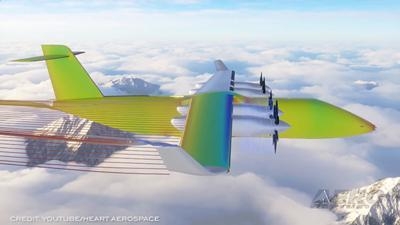Matters of the Heart
In furtherance of the axiomatic truth that there is no upper-limit to the sums of money Western airlines are willing to invest in green optics and the furtherance of the climate disaster narrative, Air Canada has announced a purchase agreement by which it will acquire thirty ES-30 electric hybrid aircraft under development by Swedish startup Heart Aerospace.

The aircraft—a concept as lovely and improbable as Boom’s Overture—does not exist. However, its forerunner, Heart Aerospace’s ES-19, has been heralded with grandiose claims the likes of:”
“The ES-19 is much quieter than any fossil-fuel aircraft, and the engine vibrations that can be felt on smaller aircraft are virtually eliminated. The aircraft is fully fly-by-wire, and actively compensates for turbulence, ensuring a smoother ride in all weather conditions. The all-metal fuselage is fully pressurized.” —Heart Aerospace website
“Our electric motor is about 20 times less expensive than a similarly-size turboprop, and about a 100 times less expensive than the cheapest turbofan. More importantly, maintenance costs are more than 100 times lower. These lower operating costs will make 19-seater electric aircraft competitive to 70-seater turboprop aircraft.” —Heart Aerospace website
“Our first-generation aircraft will have a maximum range of up to 400-kilometers (250 miles), which will increase as battery energy densities improve.” —Heart Aerospace website
Notwithstanding the glamourous, pristinely virtuous fanfare in which it’s framed, Heart Aerospace’s 19-seat ES-19 is as non-existent as its 30-seat ES-30 evolution.
Nevertheless, airlines such as United, Finnair, and BRA have committed north of $1.3-billion to the acquisition of hundreds of lovely-sounding airplanes for which functioning prototypes have yet to be built, and key technologies have yet to be developed.
In addition to securing thirty ES-30 aircraft, Air Canada has acquired a $5-million equity stake in Heart Aerospace—a development of which Air Canada president and CEO Michael Rosseau asserts: "Air Canada has taken a leadership position in the industry to address climate change. The introduction into our fleet of the ES-30 electric regional aircraft from Heart Aerospace will be a step forward to our goal of net zero emissions by 2050. Already, Air Canada is supporting the development of new technologies, such as sustainable aviation fuels and carbon capture, to address climate change. We are now reinforcing our commitment by investing in revolutionary electric aircraft technology, both as a customer for the ES-30 and as an equity partner in Heart Aerospace."

Heart Aerospace alleges its ES-30 will be powered by lithium-ion batteries, will be quieter, will be more reliable, and will have a smaller environmental footprint than conventional turbo-prop aircraft. Heart further claims the ES-30 will be equipped with reserve, sustainable-aviation-fuel-burning hybrid generators.
Fully loaded, the ES-30 is projected to have an all-electric, zero-emission range of 200-kilometers that can be extended with power supplemented by the generators. Charging time for ES-30 is expected to be 30-to-50 minutes.
Whether or not Heart Aerospace delivers on its $1.3-billion promise remains to be seen. What can be stated with certainty, however, is that $5-million is a small price for an airline to pay for the opportunity to adorn itself in shades of green, and that the viability of Heart Aerospace’s concepts—as well as those of goodly number of equally artful climate-hustling aircraft concerns—will be predicated upon a protracted sequence of highly-improbable technological miracles.
 ANN's Daily Aero-Term (04.25.24): Airport Rotating Beacon
ANN's Daily Aero-Term (04.25.24): Airport Rotating Beacon ANN's Daily Aero-Linx (04.25.24)
ANN's Daily Aero-Linx (04.25.24) Klyde Morris (04.22.24)
Klyde Morris (04.22.24) Airborne 04.24.24: INTEGRAL E, Elixir USA, M700 RVSM
Airborne 04.24.24: INTEGRAL E, Elixir USA, M700 RVSM Airborne 04.22.24: Rotor X Worsens, Airport Fees 4 FNB?, USMC Drone Pilot
Airborne 04.22.24: Rotor X Worsens, Airport Fees 4 FNB?, USMC Drone Pilot




